Coupling Influence between Recycled Ceramics and Grazed Hollow Beads on Mechanical Properties and Thermal Conductivity of Recycled Thermal Insulation Concrete
Abstract
1. Introduction
2. Materials and Methods
2.1. Raw Materials and Mixing Proportions
2.2. Specimen Casting and Curing Conditions
2.3. Experimental Methods
2.3.1. Workability Properties Test
2.3.2. Mechanical Properties Test
2.3.3. Thermal Insulation Properties Test
2.3.4. Materials Characterization Tests
3. Results and Discussion
3.1. Coupled Influence of RCE and GHB on Macroscopic Comprehensive Characteristics of RTIC
3.1.1. Workability and Density Properties of RTIC
3.1.2. Analysis of the Compressive Strength of RTIC
3.1.3. Analysis on Splitting Tensile Strength of RTIC
3.1.4. Insulation Properties of RTIC
3.2. Coupled Influence of RCE and GHB on Material Properties of RTIC
3.2.1. Material Morphology Analysis of RTIC
3.2.2. Hydration Products Analysis of RTIC
3.2.3. Functional Group Changes of RCTIC
3.3. Mathematical Representation of the Coupled Influence of RCE and GHB
4. Conclusions
- RCE can inhibit the density and mechanical properties of RTIC, but it has little effect on the working and thermal insulation properties of RTIC. GHB can improve the workability and insulation properties of RTIC (155.6 and 91.9% maximum increase), but decreases the density and mechanical properties (9.9 and 33.9% maximum decrease).
- The incorporation of GHB and RCE inhibited the formation of CH and C-S-H and promoted the increase of CaCO3, which was detrimental to the macroscopic mechanical properties of RTIC. Meanwhile, the increase in GHB led to an increase in the production of Tobermorite, which largely improves the insulation properties of RTIC.
- GHB and RCE can be used to prepare regenerated thermal insulation concrete due to the synergistic development of mechanical properties and thermal insulation properties. It is considered that 10% RCE and 60% GHB are the best doping amounts. The new thermal insulation concrete material prepared based on this material design system can be used in practical projects such as prefabricated roof structures in civil engineering, special transportation pipelines, and link bridges in equipment and accessory buildings.
- GHB and RCE can be used to prepare regenerated thermal insulation concrete due to the synergistic development of mechanical properties and thermal insulation properties. It is considered that 10% RCE and 60% GHB are the best doping amounts.
Author Contributions
Funding
Institutional Review Board Statement
Informed Consent Statement
Data Availability Statement
Conflicts of Interest
References
- Ogawa, Y.; Bui, P.T.; Kawai, K.; Sato, R. Effects of porous ceramic roof tile waste aggregate on strength development and carbonation resistance of steam-cured fly ash concrete. Constr. Build. Mater. 2020, 236, 117462. [Google Scholar] [CrossRef]
- Siddique, S.; Shrivastava, S.; Chaudhary, S. Durability properties of bone china ceramic fine aggregate concrete. Constr. Build. Mater. 2018, 173, 323–331. [Google Scholar] [CrossRef]
- Luo, W. Analysis of Strengthening the Application of External Wall Insulation Materials in Green Building Energy Saving Project. Insight-Mater. Sci. 2020, 3, 32–35. [Google Scholar] [CrossRef]
- Kumar, P. Self-compacting concrete: Methods of testing and design. J. Inst. Eng. India Civ. Eng. Div. 2006, 86, 145–150. [Google Scholar]
- Mo, K.H.; Alengaram, U.J.; Jumaat, M.Z.; Yap, S.P. Feasibility study of high volume slag as cement replacement for sustainable structural lightweight oil palm shell concrete. J. Clean. Prod. 2015, 91, 297–304. [Google Scholar] [CrossRef]
- Manfredi, S.; Pant, R.; Pennington, D.W.; Versmann, A. Supporting environmentally sound decisions for waste management with LCT and LCA. Int. J. Life Cycle Assess. 2011, 16, 937–939. [Google Scholar] [CrossRef]
- Nepomuceno, M.C.; Isidoro, R.A.; Catarino, J.P. Mechanical performance evaluation of concrete made with recycled ceramic coarse aggregates from industrial brick waste. Constr. Build. Mater. 2018, 165, 284–294. [Google Scholar] [CrossRef]
- Bao, Z.; Lu, W.; Chi, B.; Yuan, H.; Hao, J. Procurement innovation for a circular economy of construction and demolition waste: Lessons learnt from Suzhou, China. Waste Manag. 2019, 99, 12–21. [Google Scholar] [CrossRef]
- El-Fadel, M.; Findikakis, A.N.; Leckie, J.O. Environmental impacts of solid waste landfilling. J. Environ. Manag. 1997, 50, 1–25. [Google Scholar] [CrossRef]
- Greenstone, M.; Hanna, R. Environmental regulations, air and water pollution, and infant mortality in India. Am. Econ. Rev. 2014, 104, 3038–3072. [Google Scholar] [CrossRef]
- Anderson, D.J.; Smith, S.T.; Au, F.T. Mechanical properties of concrete utilising waste ceramic as coarse aggregate. Constr. Build. Mater. 2016, 117, 20–28. [Google Scholar] [CrossRef]
- Mehta, P.K.; Meryman, H. Tools for reducing carbon emissions due to cement consumption. Structure 2009, 1, 11–15. [Google Scholar]
- Flower, D.J.; Sanjayan, J.G. Green house gas emissions due to concrete manufacture. Int. J. Life Cycle Assess. 2007, 12, 282–288. [Google Scholar] [CrossRef]
- Rashad, A.M.; Sadek, D.M.; Hassan, H.A. An investigation on blast-furnace stag as fine aggregate in alkali-activated slag mortars subjected to elevated temperatures. J. Clean. Prod. 2016, 112, 1086–1096. [Google Scholar] [CrossRef]
- Batayneh, M.; Marie, I.; Asi, I. Use of selected waste materials in concrete mixes. Waste Manag. 2007, 27, 1870–1876. [Google Scholar] [CrossRef]
- Ostrowski, K.; Stefaniuk, D.; Sadowski, Ł.; Krzywiński, K.; Gicala, M.; Różańska, M. Potential use of granite waste sourced from rock processing for the application as coarse aggregate in high-performance self-compacting concrete. Constr. Build. Mater. 2020, 238, 117794. [Google Scholar] [CrossRef]
- Zeng, Y.; He, Z.; Li, M. Core–shell structured monodisperse carbon-rich SiO1.31C1.46H0.81 ceramic spheres as anodes for high-capacity lithium-ion batteries. Nanotechnology 2021, 32, 190002. [Google Scholar] [CrossRef]
- Chen, T.; Wang, H.; Su, W.; Wang, X.; Mehmood, F.; Zhang, K.; Huo, T.; Wang, C. Thermoelectric performance of Dy/Y co-doped SrTiO3 ceramic composites with submicron A2Ti2O7 (A = Dy, Y) pyrochlore. J. Phys. D Appl. Phys. 2021, 54, 155501. [Google Scholar]
- Ge, Q.; Gu, D.; Dai, D.; Ma, C.; Sun, Y.; Shi, X.; Li, Y.; Zhang, H.; Chen, H. Mechanisms of laser energy absorption and melting behavior during selective laser melting of titanium-matrix composite: Role of ceramic addition. J. Phys. D Appl. Phys. 2021, 54, 115103. [Google Scholar] [CrossRef]
- Li, L.G.; Ouyang, Y.; Zhuo, Z.Y.; Kwan, A.K.H. Adding ceramic polishing waste as filler to reduce paste volume and improve carbonation and water resistances of mortar. Adv. Bridge Eng. 2021, 2, 3. [Google Scholar] [CrossRef]
- Senthamarai, R.M.; Manoharan, P.D. Concrete with ceramic waste aggregate. Cem. Concr. Compos. 2005, 27, 910–913. [Google Scholar] [CrossRef]
- Duan, Z.; Poon, C.S.; Xiao, J. Using artificial neural networks to assess the applicability of recycled aggregate classification by different specifications. Mater. Struct. 2017, 50, 1–14. [Google Scholar] [CrossRef]
- Xianggang, Z.; Shuren, W.; Xiang, G. Mechanical Properties of Recycled Aggregate Concrete Subjected to Compression Test. J. Eng. Sci. Technol. Rev. 2018, 11, 20–25. [Google Scholar] [CrossRef]
- Correia, J.R.; de Brito, J.; Pereira, A.S. Effects on concrete durability of using recycled ceramic aggregates. Mater. Struct. 2006, 39, 169–177. [Google Scholar] [CrossRef]
- Daniel, R.J.; Sangeetha, S.P. Experimental study on concrete using waste ceramic as partial replacement of aggregate. Mater. Today Proc. 2021, 45, 6603–6608. [Google Scholar] [CrossRef]
- Beregovoi, A.; Derina, M. Assessment of the Effect of Energy Saving and Heat Loss through External Enclosure Structures with Low Resistance to Air Penetration. In IOP Conference Series: Materials Science and Engineering; IOP Publishing: Bristol, UK, 2020; Volume 960. [Google Scholar]
- Yu, L.; Wang, H.; Wang, X.; Feng, G. Study on the measurement of indoor environment quality and enclosure structure thermal defects of green residential buildings in severe cold areas. Procedia Eng. 2017, 205, 3373–3380. [Google Scholar] [CrossRef]
- Wang, Y.; Li, B.; Chen, C.; Jia, H. Influence of groundwater level fluctuation on lateral deformation of cantilever enclosure structure of pit-in-pit. Mar. Georesour. Geotechnol. 2020, 38, 108–113. [Google Scholar] [CrossRef]
- Zhang, Y.; Wang, Y.; Zhou, J. Research on two-dimensional heat transfer characteristic of enclosure structure. In IOP Conference Series: Earth and Environmental Science; IOP Publishing: Bristol, UK, 2019; Volume 252. [Google Scholar]
- Liao, Y.; Zhan, J.H.; Li, C. Research on the Construction Monitoring for Enclosure Structure of Working well. Appl. Mech. Mater. 2014, 580, 797–800. [Google Scholar] [CrossRef]
- Katunský, D.; Bagoňa, M.; Baláž, R.; Lopušniak, M.; Zozulák, M. Long-term monitoring of the thermal insulation properties of building envelope structures in real climatic conditions. In IOP Conference Series: Materials Science and Engineering; IOP Publishing: Bristol, UK, 2018; Volume 415. [Google Scholar]
- Yang, Q.; Kong, L.; Tong, H.; Wang, X. Evaluation Model of Environmental Impacts of Insulation Building Envelopes. Sustainability 2020, 12, 2258. [Google Scholar] [CrossRef]
- Ma, G.; Zhang, Y.; Li, Z. Influencing factors on the interface microhardness of lightweight aggregate concrete consisting of glazed hollow bead. Adv. Mater. Sci. Eng. 2015, 2015, 1–15. [Google Scholar] [CrossRef][Green Version]
- Wu, H.C.; Sun, P. New building materials from fly ash-based lightweight inorganic polymer. Constr. Build. Mater. 2007, 21, 211–217. [Google Scholar] [CrossRef]
- Chai, Y.L.; Song, Z.Q.; Li, Z.; Zhao, L. Experimental study on working performance of bearing and insulating concrete with glazed micro-beads. J. Constr. Technol. 2013, 42, 83–87. [Google Scholar]
- Huang, X.; Yao, W.; Pang, J. Carbonation Resistance Performance and Micro-Structure Analysis of Glazed Hollow Bead Insulation Concrete. Infrastructures 2019, 4, 63. [Google Scholar] [CrossRef]
- Song, B.; Yao, L.; Li, B. Calculation and Analysis of Heat Transfer Performance of Vitrified Micro-Bead Recycled Concrete Composite Columns Based on ANSYS. In Proceedings of the International Conference on Biology, Chemistry and Medical Engineering, Hefei, China, 29 June 2019. [Google Scholar]
- Sekar, T.; Ganesan, N.; Nampoothiri, N.V.N. Studies on strength characteristics on utilization of waste materials as coarse aggregate in concrete. Int. J. Eng. Sci. Technol. 2011, 3, 5436–5440. [Google Scholar]
- GB/T 50081-2002. Standard for Test Methods of Mechanical Properties of Ordinary Concrete, China; Ministry of Construction of the People’s Republic of China: Beijing, China, 2007.
- GB/T 10294-2008. Determination of Steady-State Thermal Resistance and Related Characteristics of Thermal Insulation Materials, China; Ministry of Construction of the People’s Republic of China: Beijing, China, 2008.
- GB/T 50080-2016. Standard for Performance Test Method of Ordinary Concrete Mixture, China; Ministry of Construction of the People’s Republic of China: Beijing, China, 2016.
- GB/T 50080-2002. Standard for Performance Test Method of Ordinary Concrete Mixture, China; Ministry of Construction of the People’s Republic of China: Beijing, China, 2003.
- GB/T 16594-2008. General Rules for Measurement of Length in Micron Scale by SEM; ISO: Geneva, Switzerland, 2008. [Google Scholar]
- GB/T 30904-2014. Inorganic Chemicals for Industrial Use: Crystal Form Analysis on X-ray Diffraction Method; ISO: Geneva, Switzerland, 2014. [Google Scholar]
- ISO 19618-2017. Measurement Method for Normal Spectral Emissivity Using Blackbody Reference with an FTIR Spectrometer; ISO: Geneva, Switzerland, 2017. [Google Scholar]
- Zhao, L.; Li, Z.; Wang, W.J. Effect of adding glazed hollow beads on mechanical properties and thermal conductivity of concrete. J. Constr. Technol. 2015, 44, 63–66. [Google Scholar]
- Liu, Z.W.; Zhao, K.; Tang, Y.F.; Hu, C.; Hu, M. Influence of lightweight aggregate on the properties of foamed concrete. J. New Build. Mater. 2019, 46, 19–23. [Google Scholar]
- Amin, M.; Tayeh, B.A.; Agwa, I.S. Effect of using mineral admixtures and ceramic wastes as coarse aggregates on properties of ultrahigh-performance concrete. J. Clean. Prod. 2020, 273, 123073. [Google Scholar] [CrossRef]
- González, J.S.; Gayarre, F.L.; Pérez, C.L.C.; Ros, P.S.; López, M.A.S. Influence of recycled brick aggregates on properties of structural concrete for manufacturing precast prestressed beams. Constr. Build. Mater. 2017, 149, 507–514. [Google Scholar] [CrossRef]
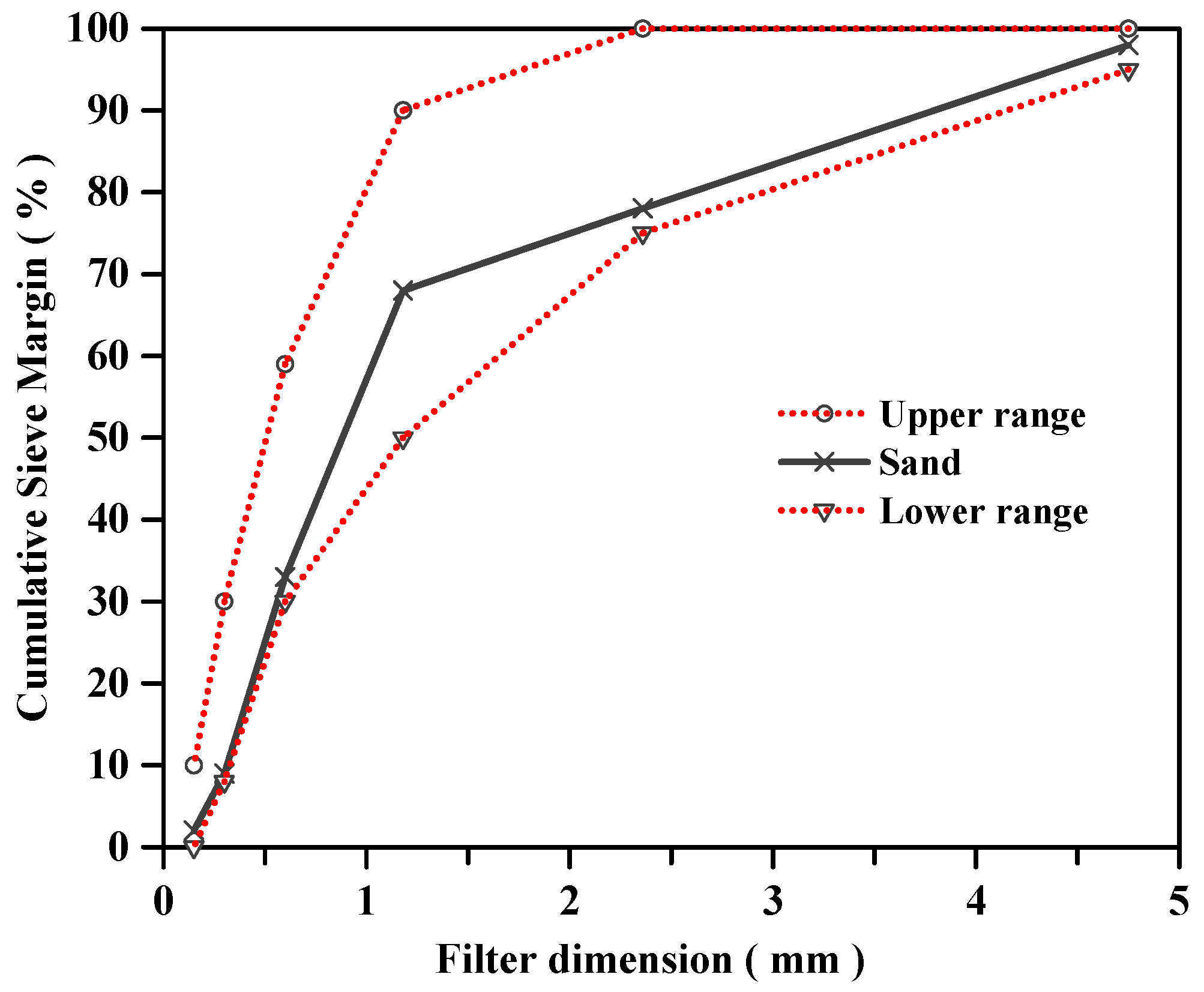




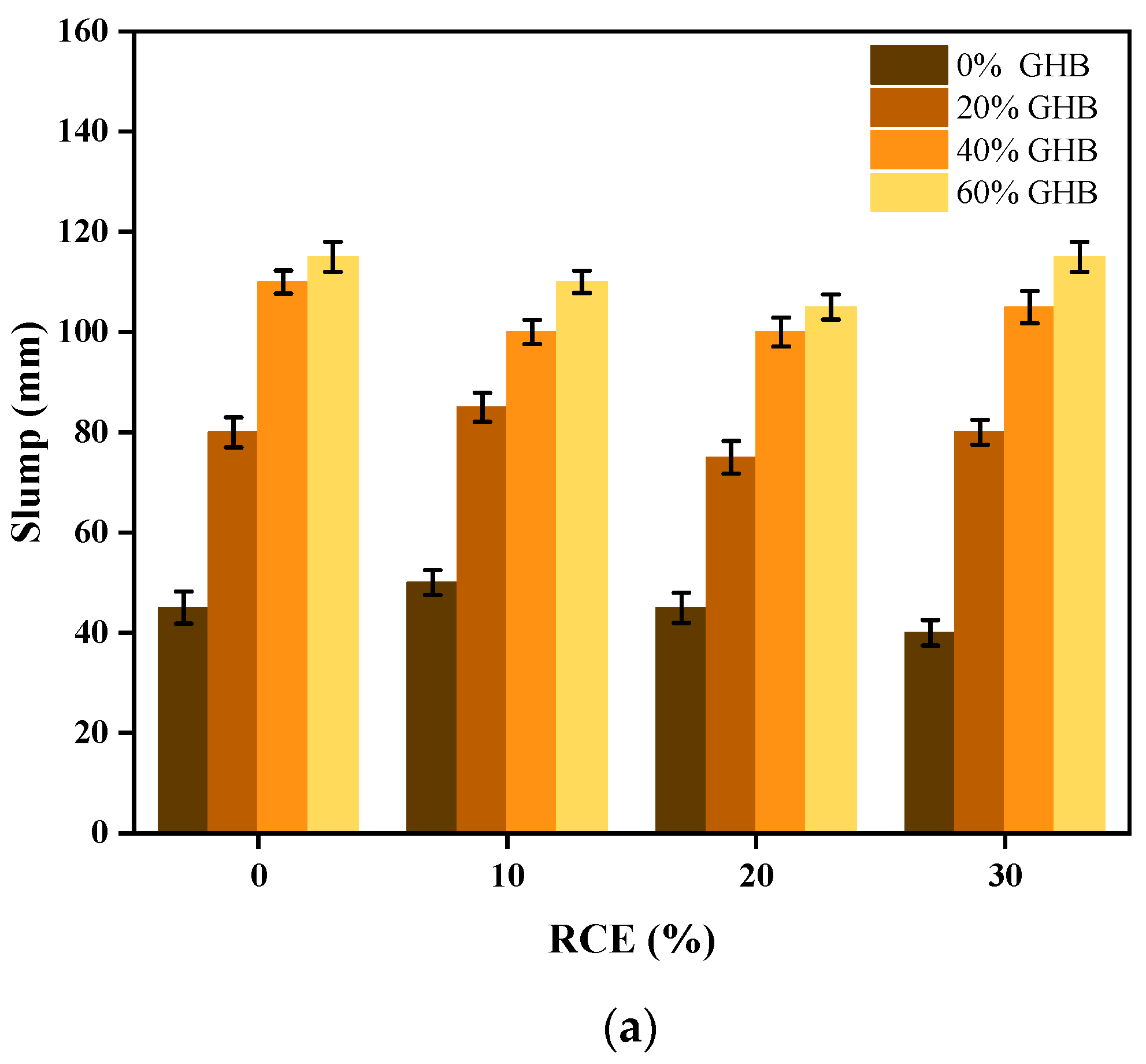
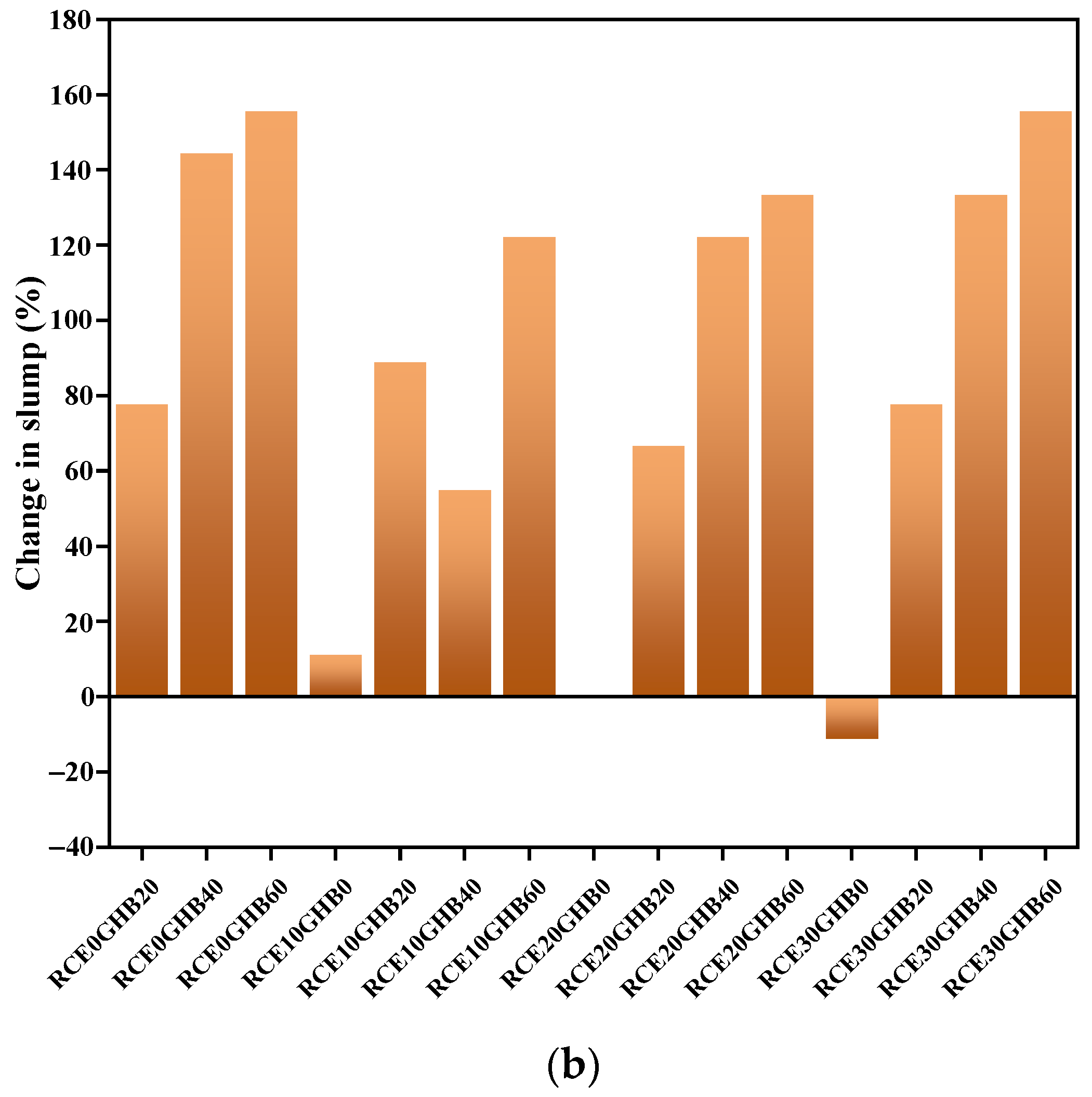

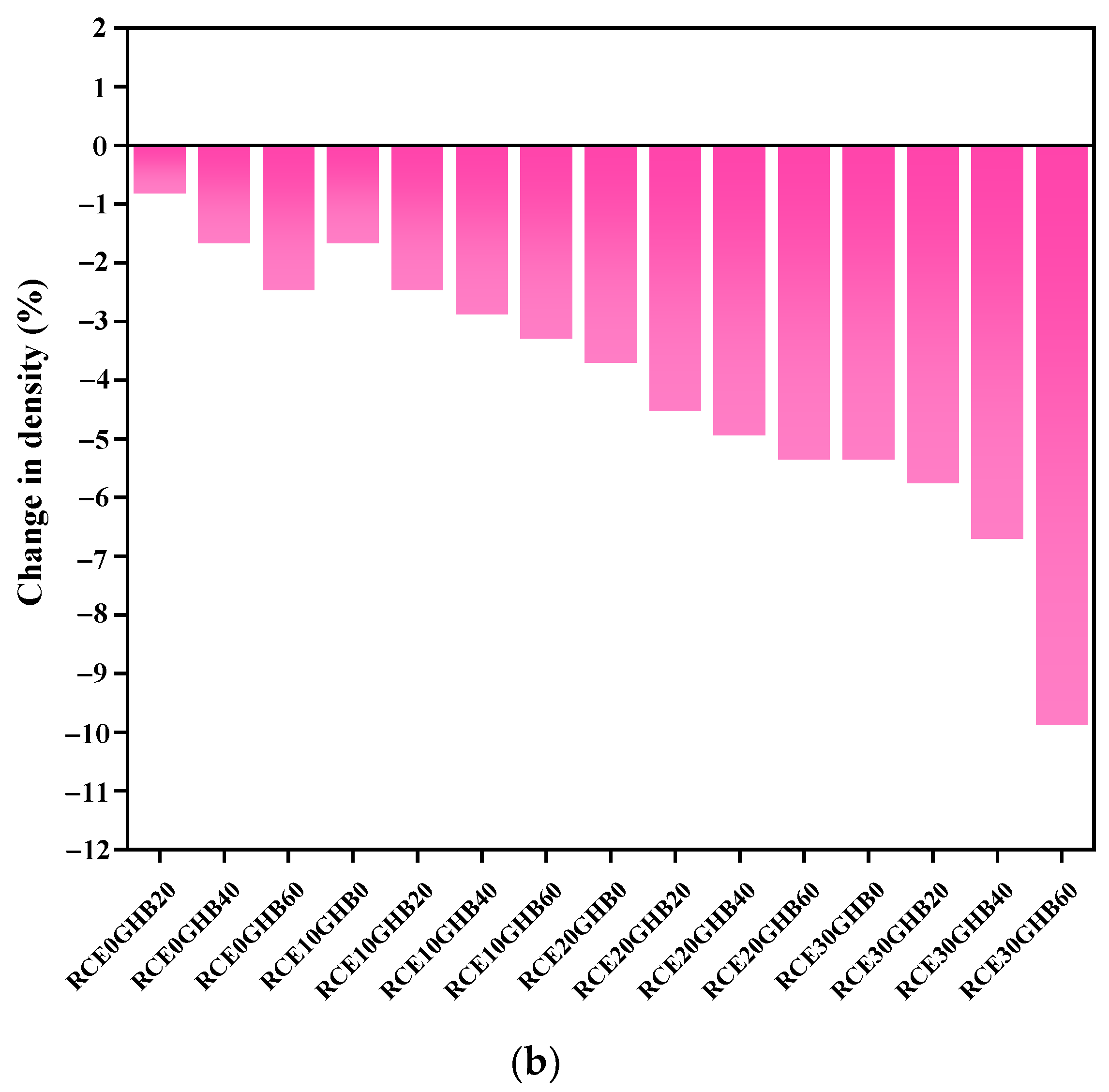

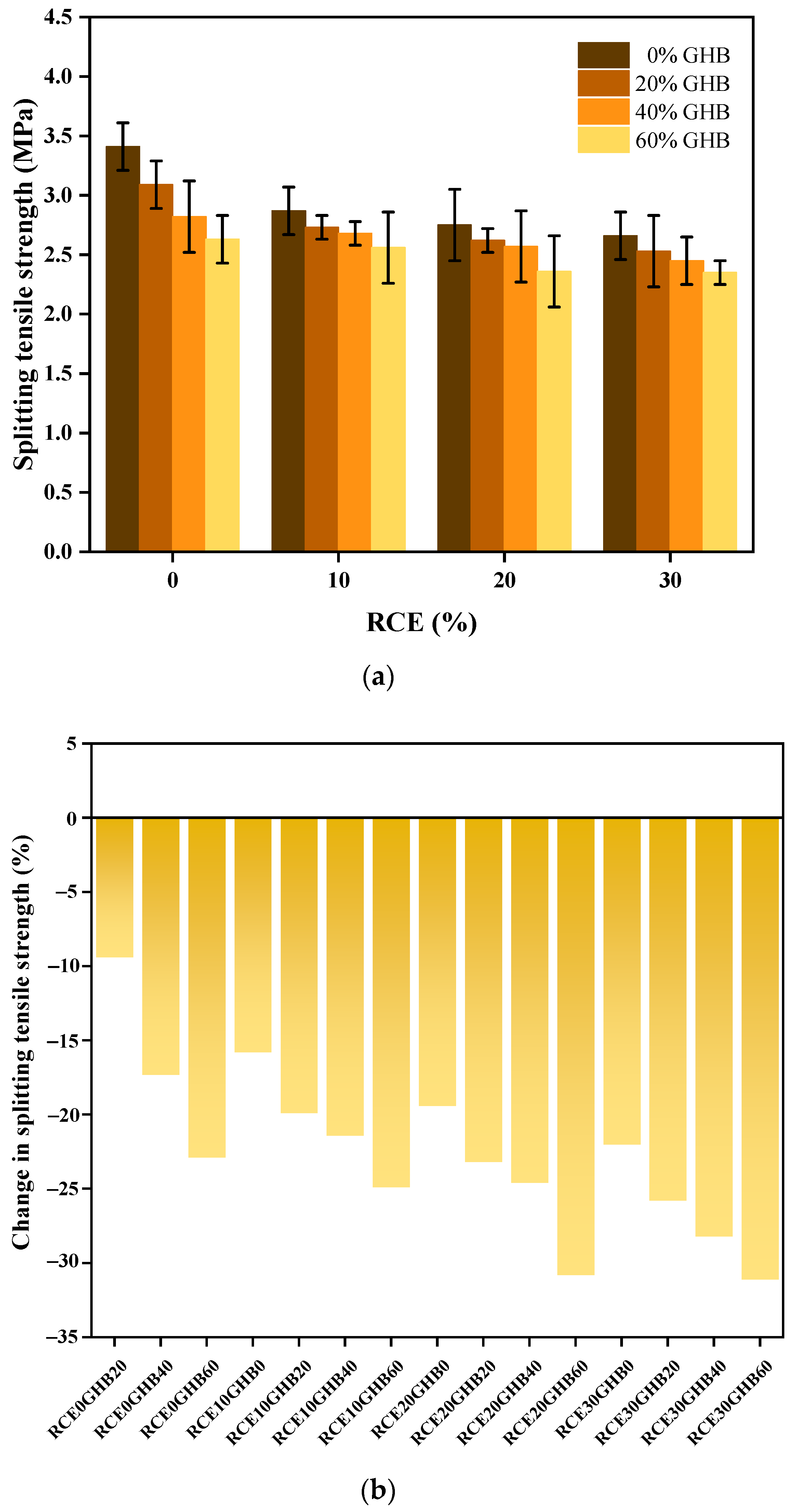

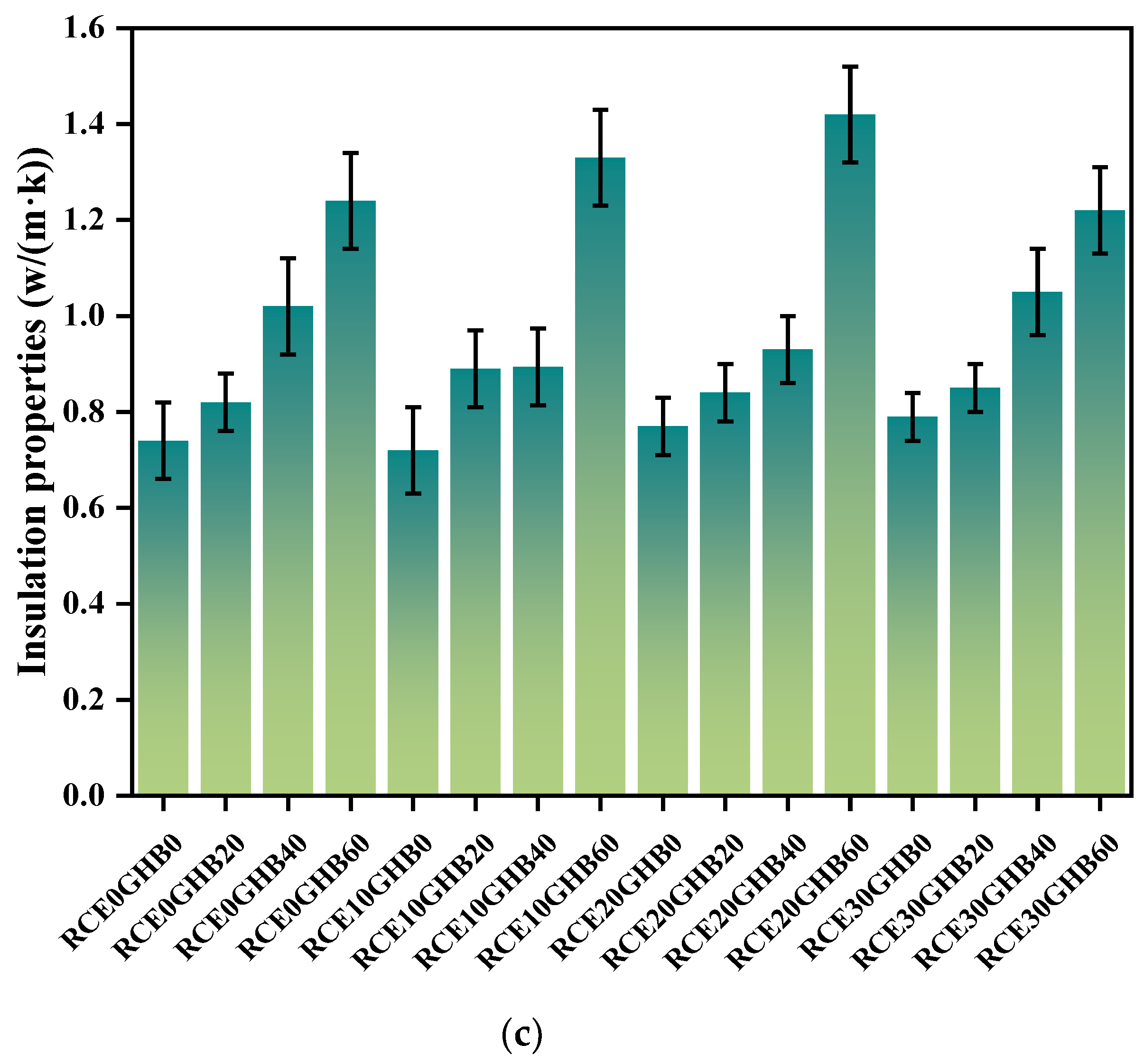
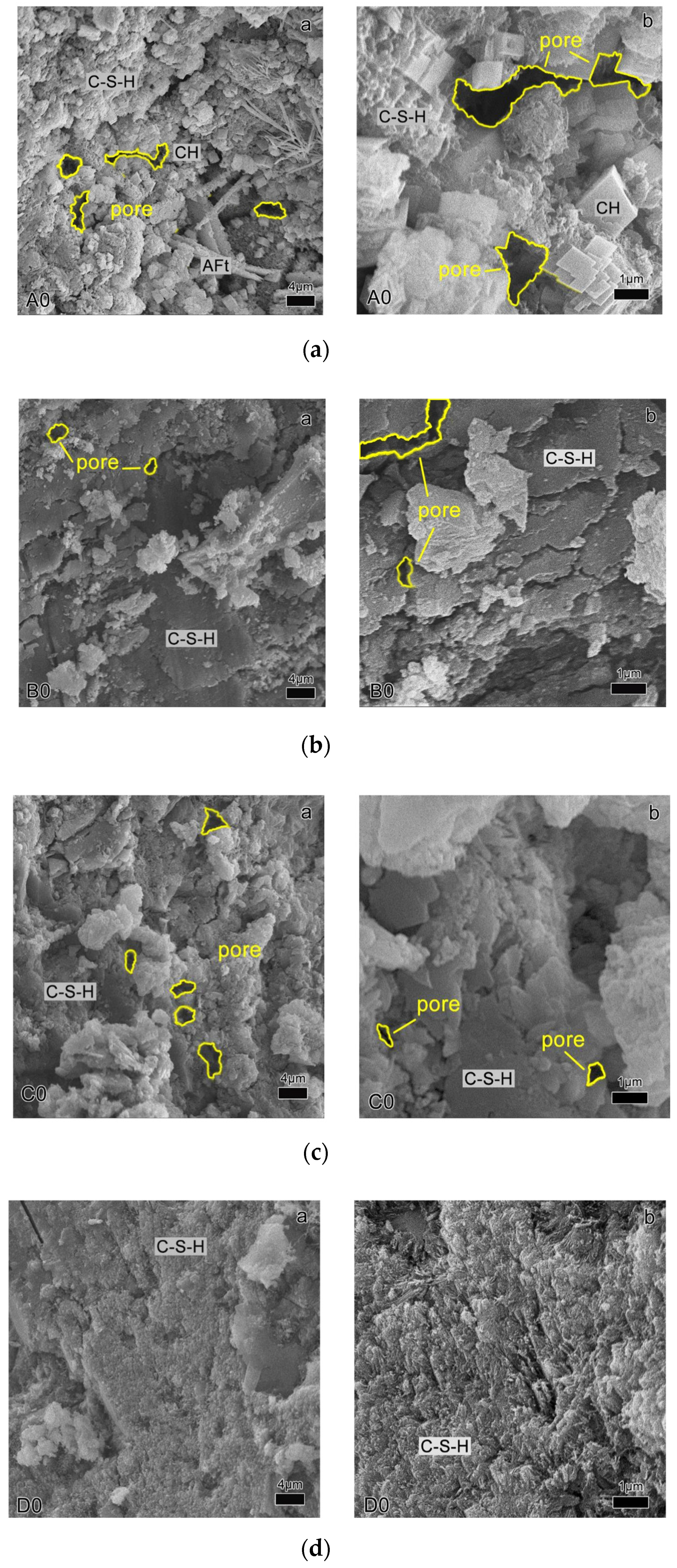


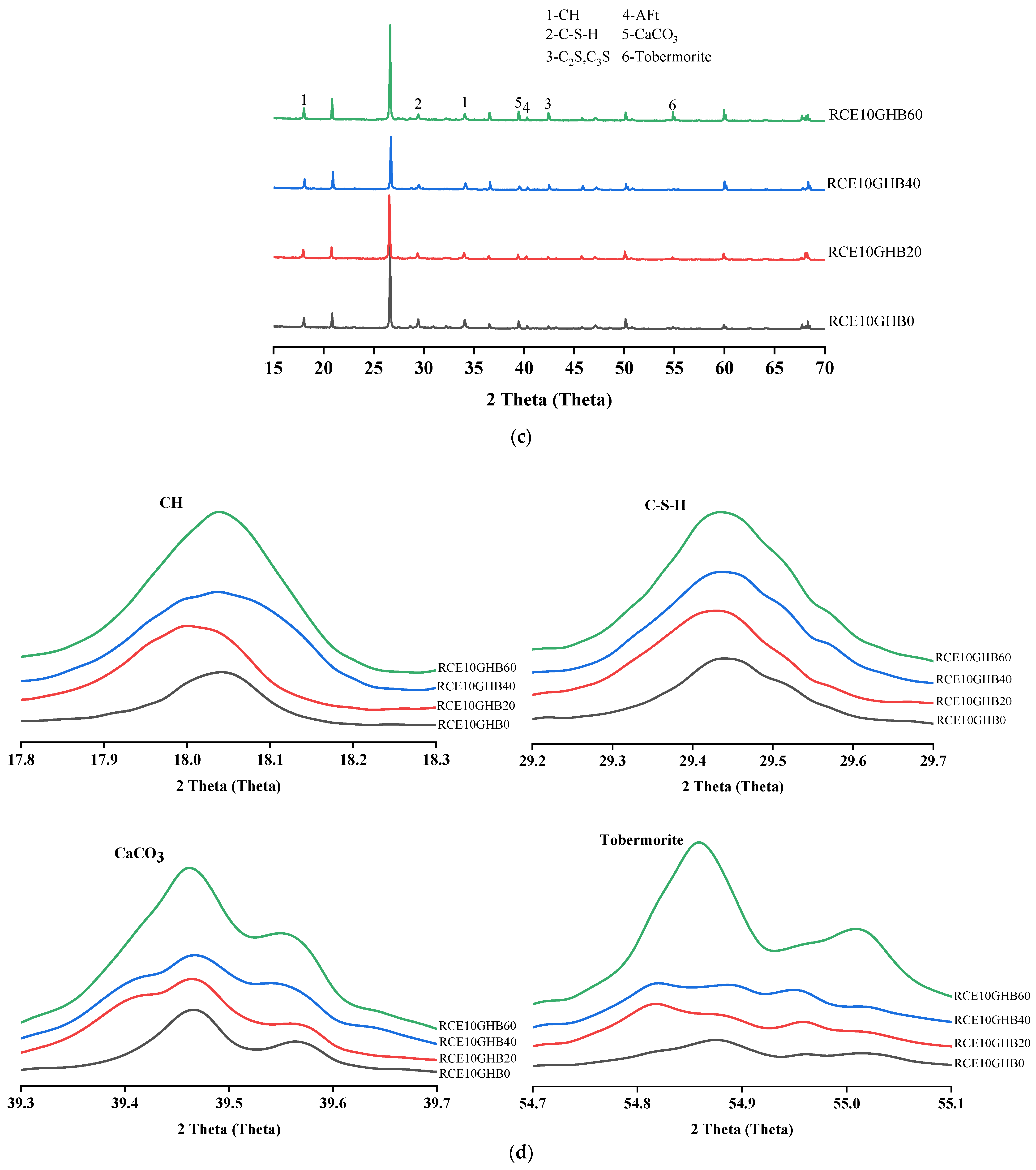


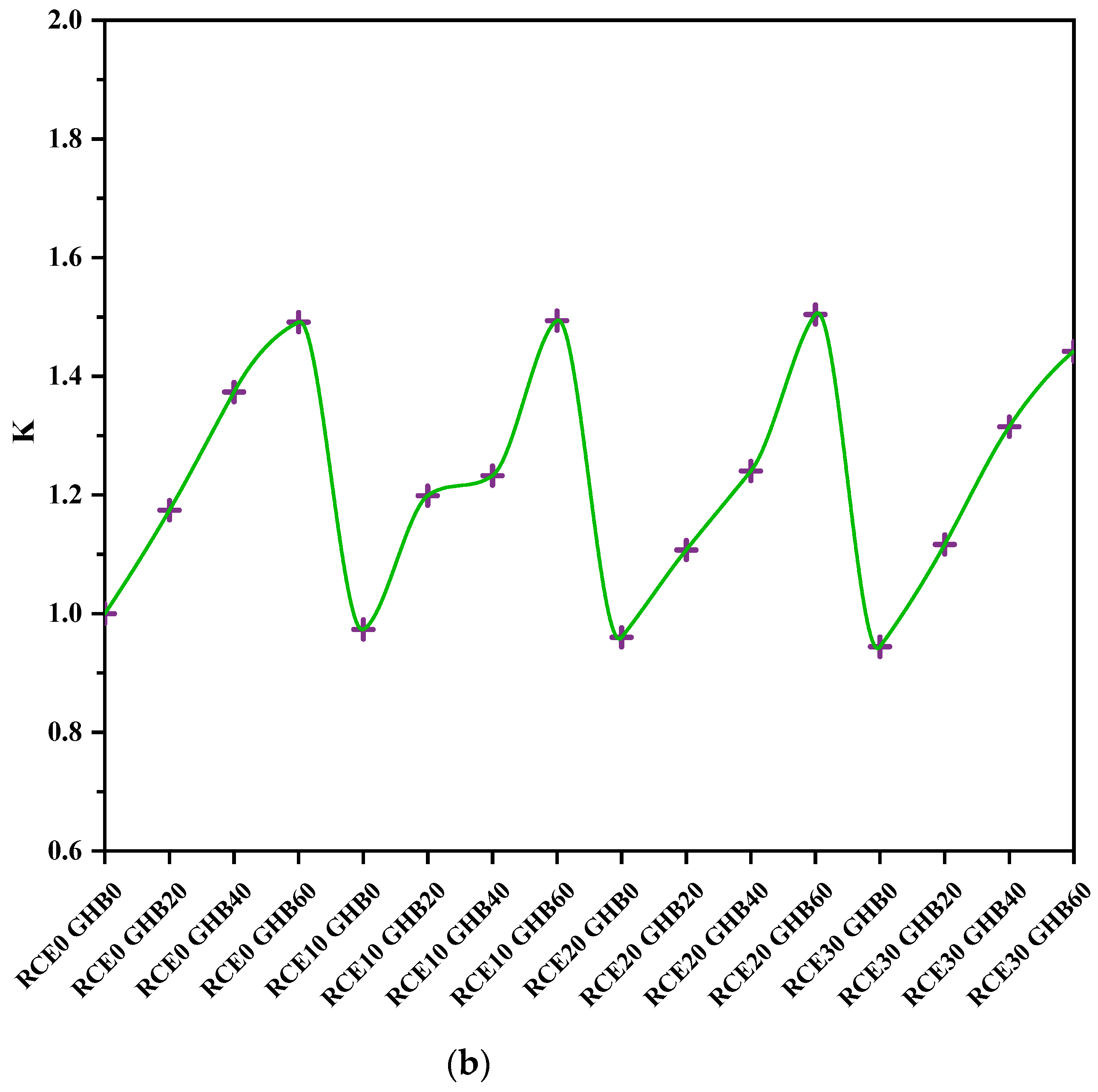
| Flexural Strength (MPa) | Compressive Strength (MPa) | Fineness | Setting Time (min) | |||
|---|---|---|---|---|---|---|
| 3 days | 28 days | 3 days | 28 days | 1.2 | Initial setting | Final setting |
| 4.2 ± 0.2 | 7.5 ± 0.5 | 23.5 ± 0.8 | 43.2 ± 0.4 | 186 | 252 | |
| Compounds | SiO2 | Al2O3 | Fe2O3 | CaO | MgO | SO3 | Loss |
|---|---|---|---|---|---|---|---|
| Content | 22.53 | 4.42 | 2.06 | 61.71 | 4.55 | 2.23 | 2.86 |
| Physical Properties | Fine Aggregate | Coarse Aggregate | ||
|---|---|---|---|---|
| Type | NSD | GHB | NSE | RCE |
| Accumulation density (kg/m3) | 2050 | 99.52 | 1389 | 972 |
| Apparent density (kg/m3) | 2512 | 174.7 | 3045 | 1819 |
| Water content (%) | 0.81 | 0.5 | 0.12 | 2.51 |
| Mass water absorption (%) | 7.58 | 246 | 0.16 | 15.47 |
| Crushing value (%) | - | - | 5.32 | 15.95 |
| Thermal conductivity (W/m·K) | - | 0.072 | - | - |
| W/C = 0.5 | Cement | Water | NSD | NSE | RCE | GHB | SP |
|---|---|---|---|---|---|---|---|
| RCE0 GHB0 | 370 | 185 | 628 | 1218 | 0 | 0 | 1.9 |
| RCE0 GHB20 | 370 | 202.8 | 628 | 1218 | 0 | 19.9 | 1.9 |
| RCE0 GHB40 | 370 | 220.5 | 628 | 1218 | 0 | 39.8 | 1.9 |
| RCE0 GHB60 | 370 | 238.3 | 628 | 1218 | 0 | 59.7 | 1.9 |
| RCE10 GHB0 | 370 | 185 | 628 | 1096 | 122 | 0 | 1.9 |
| RCE10 GHB20 | 370 | 202.8 | 628 | 1096 | 122 | 19.9 | 1.9 |
| RCE10 GHB40 | 370 | 220.5 | 628 | 1096 | 122 | 39.8 | 1.9 |
| RCE10 GHB60 | 370 | 238.3 | 628 | 1096 | 122 | 59.7 | 1.9 |
| RCE20 GHB0 | 370 | 185 | 628 | 974 | 244 | 0 | 1.9 |
| RCE20 GHB20 | 370 | 202.8 | 628 | 974 | 244 | 19.9 | 1.9 |
| RCE20 GHB40 | 370 | 220.5 | 628 | 974 | 244 | 39.8 | 1.9 |
| RCE20 GHB60 | 370 | 238.3 | 628 | 974 | 244 | 59.7 | 1.9 |
| RCE30 GHB0 | 370 | 185 | 628 | 853 | 365 | 0 | 1.9 |
| RCE30 GHB20 | 370 | 202.8 | 628 | 853 | 365 | 19.9 | 1.9 |
| RCE30 GHB40 | 370 | 220.5 | 628 | 853 | 365 | 39.8 | 1.9 |
| RCE30 GHB60 | 370 | 238.3 | 628 | 853 | 365 | 59.7 | 1.9 |
Publisher’s Note: MDPI stays neutral with regard to jurisdictional claims in published maps and institutional affiliations. |
© 2021 by the authors. Licensee MDPI, Basel, Switzerland. This article is an open access article distributed under the terms and conditions of the Creative Commons Attribution (CC BY) license (https://creativecommons.org/licenses/by/4.0/).
Share and Cite
Yu, Y.; Li, B.; Luo, D. Coupling Influence between Recycled Ceramics and Grazed Hollow Beads on Mechanical Properties and Thermal Conductivity of Recycled Thermal Insulation Concrete. Materials 2021, 14, 4695. https://doi.org/10.3390/ma14164695
Yu Y, Li B, Luo D. Coupling Influence between Recycled Ceramics and Grazed Hollow Beads on Mechanical Properties and Thermal Conductivity of Recycled Thermal Insulation Concrete. Materials. 2021; 14(16):4695. https://doi.org/10.3390/ma14164695
Chicago/Turabian StyleYu, Ying, Ben Li, and Dongmei Luo. 2021. "Coupling Influence between Recycled Ceramics and Grazed Hollow Beads on Mechanical Properties and Thermal Conductivity of Recycled Thermal Insulation Concrete" Materials 14, no. 16: 4695. https://doi.org/10.3390/ma14164695
APA StyleYu, Y., Li, B., & Luo, D. (2021). Coupling Influence between Recycled Ceramics and Grazed Hollow Beads on Mechanical Properties and Thermal Conductivity of Recycled Thermal Insulation Concrete. Materials, 14(16), 4695. https://doi.org/10.3390/ma14164695






